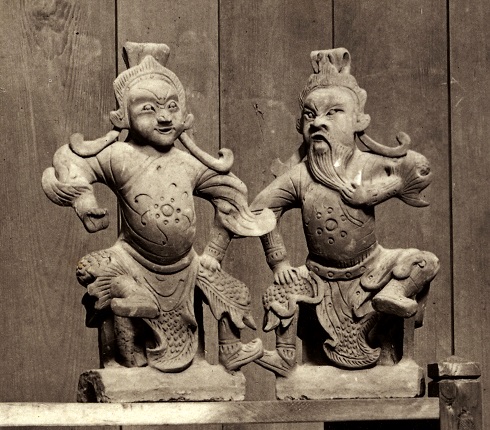Workshop: unknown, possibly from the vicinity of Beijing (Beijing) or Shenyang
Architectural detail; burnt clay; stamping in a die, manual processing, burning
Measurements: unknown
Provenance: China, Ming Dynasty, Chongzhen Emperor Period (1628–1644) or Qing Dynasty, Kangxi Emperor Period (1644–1722).
In 1909, 25 pieces of glazed and terracotta architectural details from the provinces of Shaanxi and Shantung were donated to Malbork by the then attachè of the German embassy in Beijing, Ernst Börschmann (1873-1949), later sinologist and founder of the Sinology Seminar at the Friedrich Wilhelm University in Berlin. In a letter to Conrad Steinbrecht, Börschmann wrote that he probably dates these and other tiles delivered at that time to the reign of Emperor Kangxi of the Qing Dynasty. Thus, the oldest ones could come from the first half of the 17th century.
Yama (Jama) – the Hindu god of death, the ruler of hell, for the Chinese he was a guarantee of meeting the dead in the afterlife, ensuring the continuity of the family through its male descendants.
Kuan-ti – Chinese commander in the service of Emperor Liu Bei (161–223 CE). Over time, his figure was identified with the god of war. He protected people from evil and injustice.
Tiles with figures of these gods had an apotropaic meaning when placed on the ridge of houses. They protected against evil, disease and disasters. They provided residents with a safe living.
Lit .: Nachrichten der Königlichen Schloßbauverwaltung zu Marienburg Westpr. über die Tätigkeit in den Baujahren 1909, 1910 and 1911, (1911), p. 13; E. Börschman, Chinesische Baukeramik, Berlin 1927 pp. 58, 63, 90; Restore history. The fate of the Malbork collections after World War II: exhibition catalog at the Castle Museum in Malbork, ed. A. Siuciak, Malbork 2015, p. 126.
Source: APM, ref. 206/549, pp. 214–222; MBj. 1910, photo 5.
(compiled by Dr. B. Pospieszna)

